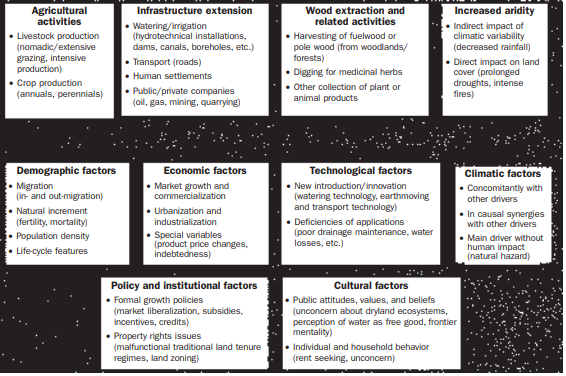Desertification
Overview
Desertification is the process in which fertile land becomes desert. The resulting loss of plant life leads to a decrease in overall bio productivity. [1] Barren soil becomes more susceptible to erosion and more vulnerable to evaporation and higher temperatures. The cause of this process is most often attributed to anthropogenic climate change, but a multitude of factors influence desertification. [2] Rapid desertification is expected to have drastic environmental, economic and political consequences.
Causes
Desertification is most attributable to human activity and climate change. According to scientists, poorly managed livestock herds has led to overgrazing of grasslands. In addition, the expansion of agriculture and deforestation have decreased overall natural vegetation. In turn, loss of vegetation has led to a host of problems resulting in the degradation of land. The change from fully grassed lands to scattered shrubbery leaves land bare and susceptible to erosion. Unprotected soil surfaces are also prone to salinization by evaporation and water logging. [3] Nutrients are washed away, fauna dies from lack of nutrients or washes away as well. Scientists have identified several driving forces behind desertification. It is contended that a combination of multiple factors are at play. [2]

Consequences
Large scale effects on agriculture are expected, most predominately in nations already afflicted by poverty. Agricultural production will drop significantly as lands will no longer have fertile land to support crops. In addition to declines in crop production, vegetation loss affects grazing livestock. Changes in landscape are also predicted to bare significant declines in tourism. A myriad of negative impacts are expected, but none more forbearing than feeding a growing population with diminishing returns. [3]
Prevention